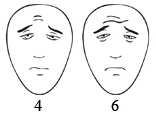What is pain?
Pain is an unpleasant feeling that can happen when there's something causing harm to your body, like an illness or injury. But sometimes it shows up even when there’s no actual illness or injury. Pain can affect your emotions as well as your body. For example, if you put your hand on a hot stove, the pain lets you know right away that you're hurt and need to protect yourself. Pain can also make you feel irritable, anxious, or depressed. You may have pain from an injury, after surgery, or from a health problem like cancer, osteoarthritis, low back pain, headaches, or fibromyalgia.
Your body feels pain through nerves in your skin and organs. These nerve endings send pain signals to your brain.
Different ways people feel pain
Pain feels different for everyone. Something that doesn't bother one person might feel very bad to someone else.
Pain can feel sharp or dull. It may throb or burn. It may be in one part of your body, such as with a headache or a stomach ulcer. Or you may feel pain all over, like when your muscles ache from intense exercise or the flu.
Some pain may be so mild that you can ignore it until it goes away. But other pain may be so bad that you can't do your daily activities without medicine or other treatment.
Acute and chronic pain
Pain may last for a short time or a long time. It may come and go, or it may be constant.
Pain that starts quickly and lasts for a short time is called acute pain . Examples include pain from an injury, a headache, childbirth, or right after surgery.
Pain that goes on for months or years is called chronic pain. Sometimes chronic pain has a clear cause, like nerve damage from diabetes. But sometimes the cause isn't clear.
What are the different types of pain?
Different types of pain affect different parts of the body. Pain can affect:
- Muscles, bones, and joints. It also affects the ligaments and tendons. This pain can happen from injuries or muscle strain. Health problems like osteoarthritis, rheumatoid arthritis, and fibromyalgia also can cause it.
- Nerves and the nervous system. This type of pain happens because of pressure on nerves or damage to them from an injury or a health problem. Problems with the central nervous system can sometimes cause pain. Diabetes, shingles, and sciatica are examples of health problems that cause nerve pain.
- Organs. Pain in your organs occurs because of injuries, infections, or other health problems. These problems include cancer, inflammatory bowel disease, irritable bowel syndrome, pelvic pain, and stomach ulcers.
Sometimes pain can happen even when there’s no illness or injury causing it. You can also have more than one kind of pain at the same time. For example, cancer can cause pain in your bones and your organs.
